
This was one of the more exciting acquisitions I made in my windfall acquisition of 1988–a super-early (single digits) issue of AMAZING SPIDER-MAN by the character’s originators, Stan Lee and Steve Ditko. And not to boast per se, but because it’s the point of this whole series of pieces, remember that I got this book for the princely sum of 33 cents–a fantastic bargain, even in 1988. It’s a pretty, pulpy cover as well, with strong coloring presumably by Stan Goldberg, who was then providing hues for practically everything at Marvel. And the cover blurb is pretty memorable (and was swiped years later on at least one occasion) and a good summation of what Spider-Man had to offer that other super heroes of this period lacked. So let’s take a look at this vintage issue a bit more closely.

First off, I should probably mention that this wasn’t the first time I read this particular story. No, I encountered it first in the second of the three paperback collections of the web-slinger’s earliest adventures in the late 1970s, a volume that cemented by love for the strip and the character. And primary among that attachment was artist Steve Ditko. His work was incredibly distinctive, and simultaneously could be creepy, realistic and genuine–and always just a little bit odd. By this seventh issue, he and scripter/editor Lee had worked out the kinks on their new creation, and settled in to put him through his paces. By this issue, this is recognizably Spider-Man, not that far removed from the way the character is depicted today.

It’s interesting to look at this issue in contrast to what DC was publishing at the same time. The story in this issue of AMAZING SPIDER-MAN is full length, it takes up the whole book, which was a rarity at DC unless you were JUSTICE LEAGUE OF AMERICA (which needed the longer length to juggle all of its stars.) It was also firmly focused on action and adversity. Where the DC books typically had their heroes grappling with some intellectual problem or puzzler, Spidey was engaged in a life-and-death struggle against a powerful adversary. The stakes, and the expression of those stakes, is night and day.
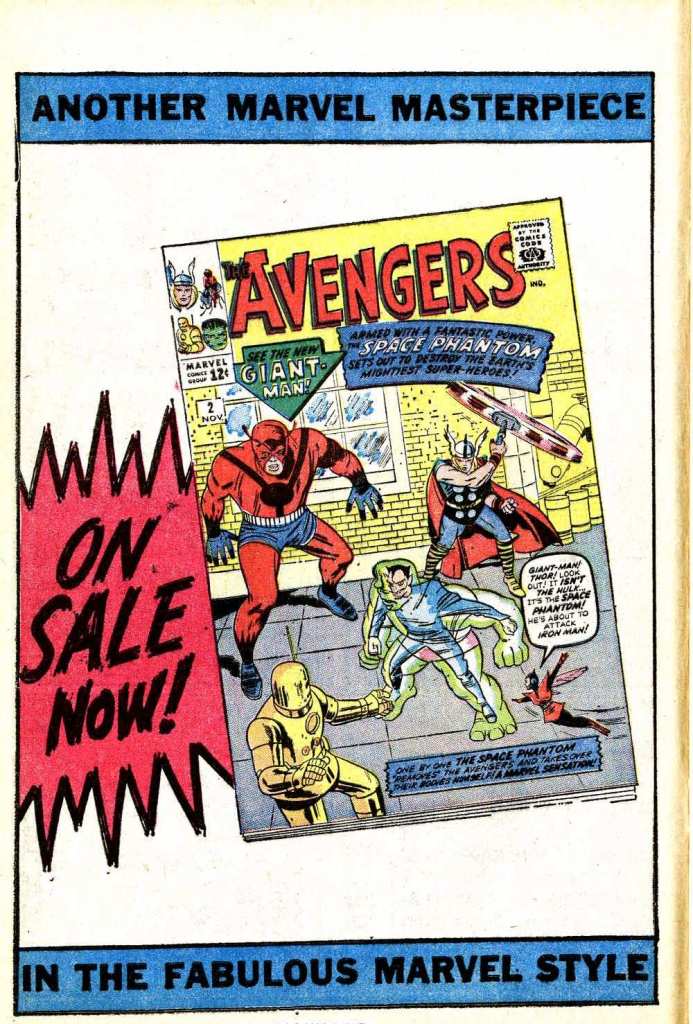
Lee had also crystalized his approach to selling the Marvel line and the Marvel mystique by this point. Say what you will about his propensity for taking too much of the credit and the spotlight for himself, Lee was also pretty much the only editor in town who was routinely giving his comics regular credits–and what’s more, using his letters pages to start to create a bit of a cult of personality around each of them. There’s more fiction than fact to a lot of it, but it was still fun and engaging for the readers. He’d also regularly run full page ads for other books in the line, such as this one for AVENGERS #2.
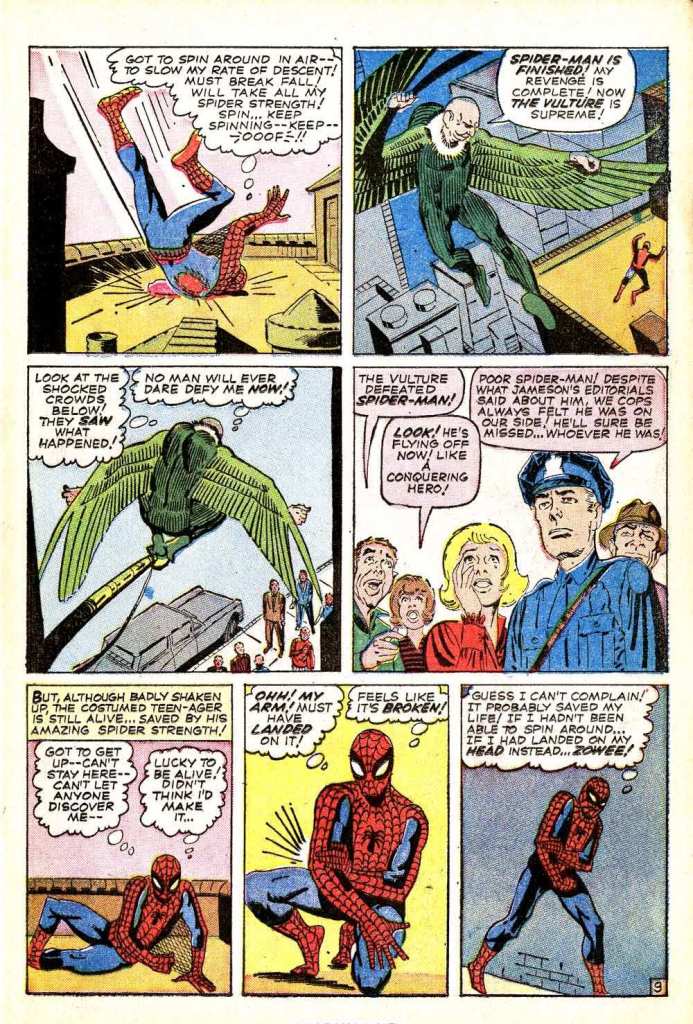
Lee and Ditko also reinforced their stakes in sequence like this one. Having heard that his old enemy the Vulture has broken out of jail, teenaged hero Peter Parker changes into his Spider-Man identity and goes looking for the high-flying criminal. He figures, as you would, that he can simply capture the Vulture again with the same gizmo he whipped up in their first battle, which neutralized the lifting power of the Vulture’s wings. But the Vulture is smarter than that, and he’s made his new wings proof against the wall-crawler’s device. The end result is that Spidey plummets from way up in the sky, landing awkwardly on his arm and shoulder, injuring them. And they stay injured, becoming a pressing issue for Spidey all throughout the rest of this adventure. None of the competition’s heroes ever seemed to get hurt in any meaningful way in their adventures (apart from the occasional exposure to Kryptonite, which might result in a >gasp, choke< sort of a reaction.) But Peter is legitimately messed up here. What’s more, he needs to explain his injury to his frail old Aunt May, whom he can never tell about his antics as Spider-Man. This stuff seems simple and simplistic now, but just look at it as compared to the issues of ACTION COMICS and ADVENTURE COMICS we looked at previously–it’s worlds ahead in terms of characterization and drama.
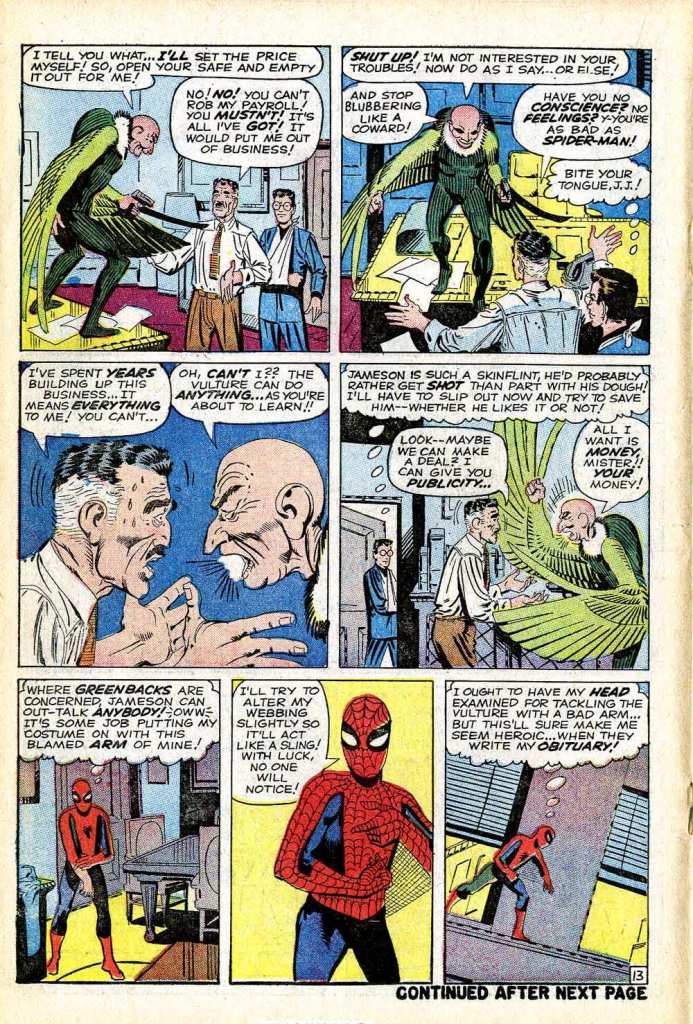
The other area where Spider-Man really hit was in mixing up action with comedy. Lee and Ditko weren’t at all afraid of bending reality a little bit for a cheap gag. So after putting himself back together, Peter heads into the Daily Bugle to try to sell the pictures he took during his first fight with the Vulture to publisher J. Jonah Jameson. Jameson in these days was overtly a comedic character, right out of a vintage radio comedy. When the Vulture shows up to rip off the Bugle’s payroll, Jameson hilariously tries to talk him out of it in fine Jack Benny style–giving Peter enough time to sneak off and switch into costume, even with his bad arm slowing him down. This is still the really early Peter, by the way, who wore horn-rimmed glasses. He wouldn’t lose those for another issue.

The whole fight here between the injured Spider-Man and his avian foe through the Daily Bugle building is wonderfully choreographed and delightfully wacky. Hemmed in by the close quarters of the offices, the Vulture is looking for a means of egress, while pursued by a slightly hampered Spider-Man and a harried Jonah Jameson, who rails against the cost of all the destruction they’re leaving in their wake. It’s exciting, but it’s also fun.

Eventually, though, the Vulture does manage to exit the building, and then the advantage goes to him. He snatches up his foe and carries him high into the air, far higher than the pair was the last time the Vulture dashed Spider-Man to the ground. But as he prepares to finish off his we-slinging foe, Spidey suddenly webs up the Vulture’s wings, causing the villain to begin to plummet groundward as well. The Vulture’s bravado deserts him at this point, and he blubbers for Spider-Man to save them–which he does, by webbing them up a makeshift parachute. This all happens in front of onlookers on the ground below, so Spidey’s reputation is restored a little bit as well.
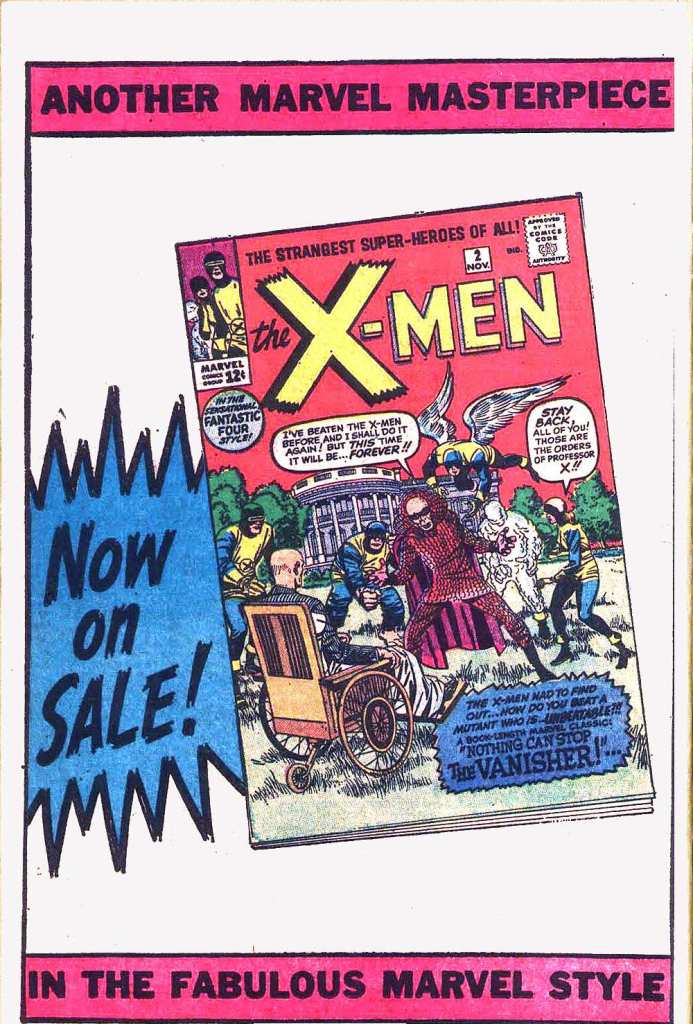
Another ad in the same template, this time for X-MEN #2. As AVENGERS and X-MEN had been launched simultaneously and most recently from the perspective of when this issue was put together, they’re given extra attention and promotion.

Then comes the wrap-up, one of the most noteworthy ones of this period, and one that moves Peter’s ongoing soap opera subplots forward just a hair. After Jameson verbally accosts him once more, Spidey retaliates for webbing the Bugle publisher’s mouth up for the first time–this would become a recurring bit over the years, but this is when it happened first. And then, changing back to his civilian identity, Peter hunkers down behind an overturned desk with Betty Brant, Jameson’s secretary, and forges a connection with her that will lead to the two of them becoming involved. And yes, this is a little bit weird and creepy from a 21st Century perspective, but Betty here was meant to be a contemporary of Peter’s in terms of her age, only a couple of years older than him at most. She’s still robbing the cradle, though. As we now know that Ditko based Betty on Lee’s secretary Flo Steinberg, and that Flo had turned Ditko down cold on a few occasions for dates, this scene takes on a greater resonance. Even without that, though, it’s a pretty great wrap-up to a pretty great adventure.
But the issue isn’t over yet–there’s still Lee’s secret weapon, the letters page. At this time, only FANTASTIC FOUR and AMAZING SPIDER_MAN were carrying letters pages (though they’d expand to the other titles before too much longer, despite Lee asking his readers permission to discontinue them here) so they were used as a clearing house for information and promotion across the line. Even in terms of the letters that were printed, look at how differently Lee handles this page than Mort Weisinger, and what his readers are concerned about. He’s quick to punctuate every response with a cheesy joke that creates a sense of playfulness throughout the page. This one includes a missive from Paul Gambaccini, who would have a long career as a broadcaster at the BBC, and who was one of DC editor Julie Schwartz’s most regular correspondents (Julie even based a character on him, the tailor to the Flash’s Rogues Gallery, Paul Gambi.) The fact that he praises Marvel so highly here had to feel like a win to Lee. The Special Announcements section was the precursor to the Bullpen Bulletins and the Mighty Marvel Checklist, and it’s astonishing just how many different titles and features Lee is able to plug here in an entertaining manner in such a short space. This feeling of fun and connectivity is a good part about what made following the Marvel titles so appealing for readers in these days.

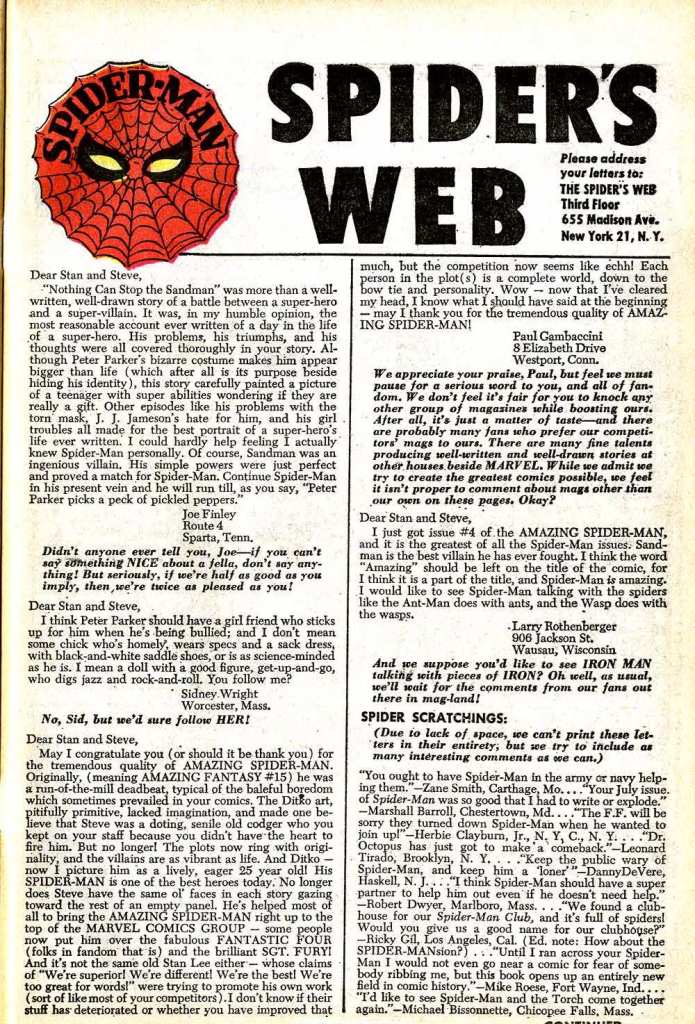
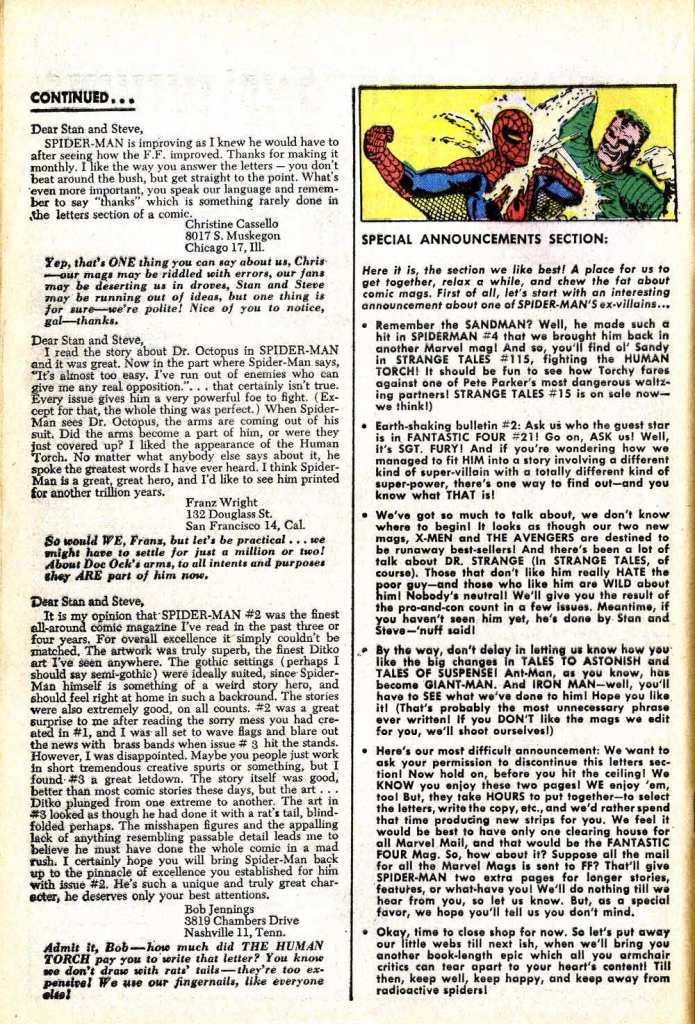
As much as I try to find a better run of any comic book it’s impossible. The first 50 books of ASM are so good. Can be read again and again. A template of brilliance
LikeLiked by 1 person
Can’t argue with you at all, @Pat. If we read AF 15 through AS-M 33, we get the story of a boy growing up – who just happened to have powers. The powers and the adventures were incredibly entertaining and done, but the boy learning to become a man. The story could have – seemed as if it – ended there.
If we continue reading through issue #40 – as terrific and NEEDED “the End of the Goblin” was and is – the learning and growth are reversed. Peter was once again in the little boy/adolescent role. It’s hard to not continue a periodical which is so popular and such a breakthrough for comics and the superhero.
It is difficult for me to believe that the Batman TV show would have even made it to the screen if Spider-Man hadn’t gotten people of all ages to start buying comics again. Suddenly, we were able to find comics of all sorts being sold in places that amazed my parents. They told me this was normal during “The War” but they thought comics were dead about the time they married.
My world would have been much worse without Spider-Man.
LikeLiked by 2 people
Ditto, although to be more accurate, I would say my world would have been much worse without Steve Ditko and Jack Kirby (and Ray Harryhausen, Rod Serling, Ray Bradbury, Gene Roddenberry, etc….)
LikeLiked by 1 person
Probably ditto. It was Ditko’s Spider-Man (issue #4 being my initial introduction) that led me to the aforementioned giants you added above. Didn’t take me long to find used copies of issues 2 and 3, as it was 1963 and every junk shop carried used comics for a nickel.
LikeLiked by 1 person
In agreement about how remarkably, amazingly good Spider-Man was in those years.
I think I prefer the Julius Schwartz books’ letter columns to Stan’s. The Schwartz responses were never as snappy as Stan’s patter, but Schwartz (or whoever picked out the letters) had a really good eye for an interesting, well-written letter.
LikeLike
Your description of Ditko’s work is spot on: “His work was incredibly distinctive, and simultaneously could be creepy, realistic and genuine–and always just a little bit odd.” From the next issue on, Ditko gradually changed his art work so that it was less odd. Parker lost his glasses and became less nerd like. The coloring became brighter and less gloomy, and he did fewer of the really small panels. In short, he became more mainstream, although always distinctive. A great series and a great post.
LikeLiked by 1 person
How did you manage the 33 cents deal??
LikeLiked by 1 person
https://tombrevoort.com/2021/07/17/windfall-comics/
LikeLike
Thanks! Great story!
LikeLike
I think you make a great point here that doesn’t get considered enough, to my mind. What Marvel was doing was so much more involving and immediate than other company’s books – you really felt a connection to these characters because they seemed so real. Yeah, it was soap opera but there’s a reason soap operas can go on for decades. Stan took the shared universe idea and ran with it, so you really wanted to read *all* the books every month to see what was going on in the Marvelverse. And where Julie was part school teacher and all Grownup, Stan was the cool Uncle who gets you the best present on your birthday, and takes you for a ride in his sportscar to get more ice cream. I knew who I wanted to hang with. I love Stan, warts and all
LikeLike
The guy that wrote that first letter is the dad of a kid I grew up with. He was the only adult I knew that still collected comics. When we hung out a lot (mid-to-late 80s) I used to just look thru his numerous long boxes in pure amazement. Still the only times I’ve ever held an Amazing Fantasy 15, FF 1, AS-M 1, and on and on… He had them all from when he was a kid and thru college and everything.
I’ve not seen the guy in a long time and don’t even know if he’s still alive. My friend died about 25 years ago. I’d love to know what happened to that collection.
LikeLike